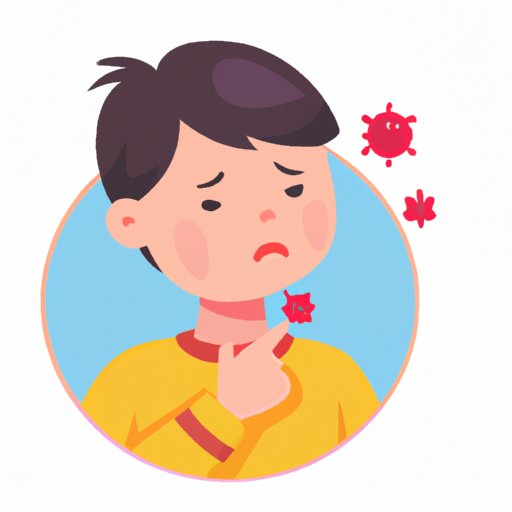
Introduction
Smallpox is a highly contagious viral disease that plagued humanity for centuries before being eradicated in 1980. While it’s no longer a threat on a global scale, smallpox is still a danger in certain situations, such as bioterrorism attacks or accidental release from labs. Recognizing the symptoms of smallpox is crucial for individuals and communities to contain outbreaks and prevent further spread. In this article, we’ll explore the symptoms of smallpox, why early detection is key, and what treatment and preventative measures are available.
Smallpox: Recognizing Symptoms and Seeking Treatment
Smallpox is caused by the variola virus and is highly contagious through respiratory droplets. Symptoms can take up to 21 days to appear after exposure and include fever, headache, fatigue, and back pain, followed by a rash that progresses to fluid-filled blisters that scab over and fall off, leaving scars. In severe cases, smallpox can cause encephalitis or a fatal hemorrhagic form.
If you suspect you or someone you know may have contracted smallpox, seek immediate medical attention. Smallpox can be diagnosed through laboratory tests and early treatment can improve outcomes, including antiviral medication and supportive care. Vaccination for smallpox is no longer offered to the public, but it is available for some high-risk groups, including military personnel and laboratory workers.
The Tell-Tale Signs of Smallpox: Identifying Symptoms
While smallpox symptoms can mimic other illnesses, there are several tell-tale signs to look out for. The fever is usually high and starts suddenly, accompanied by chills, vomiting, and intense headache. Within a few days, a rash begins on the face before spreading to the trunk and limbs, with lesions that progress to pustules and then scabs. Smallpox lesions are generally uniform in size and distribution, while the mouth, throat, and genitalia may also be affected.
If you suspect smallpox in yourself or someone else, isolate the person as soon as possible and contact your public health department or healthcare provider. Avoid contact with those who may not have been vaccinated or who have weakened immune systems, such as children, the elderly, and individuals with chronic conditions.
Smallpox Outbreak: Understanding Symptoms and Prevention
Smallpox outbreaks can occur in populations with low vaccination rates or in areas with limited access to healthcare. The disease is prevented through vaccination, maintaining good hygiene practices, and isolating infected individuals. During outbreaks, individuals should watch for symptoms in themselves and others, and avoid contact with sick individuals. Mass vaccination campaigns may be necessary to contain the spread of the disease.
If you live in an area with a known outbreak of smallpox, take extra precautions to protect yourself and your family. This includes avoiding public gatherings, practicing good hygiene, and staying informed about local recommendations.
Smallpox Symptoms: Why Early Detection is Key
Early detection of smallpox is crucial to improving outcomes and preventing spread. The disease can be fatal in up to 30% of cases, with a higher mortality rate in children. The earlier the diagnosis, the more effective treatment can be in controlling symptoms and reducing complications. Close monitoring of symptoms and temperature, as well as seeking medical attention right away, can make a significant difference in treatment outcomes.
It’s important to note that even if you’ve been vaccinated for smallpox, immunity may wane over time, and re-vaccination may be necessary for those at high risk of exposure. Consult with your healthcare provider about your risk and vaccination status.
From Fever to Rash: A Comprehensive Guide to Smallpox Symptoms
Smallpox symptoms can present in stages, with each stage lasting a few days.
Stage 1 (Invasion):
- Fever of at least 101°F
- Headache
- Malaise
- Back pain
Stage 2 (Early Rash):
- Flat, red spots appear on the face and limbs
- Spots progress to raised bumps (papules)
- Bumps fill with fluid and become dome-shaped (vesicles)
Stage 3 (Pustular Rash):
- Blisters form in the vesicles
- Blisters fill with pus and become pustules
- Pustules begin to crust over
Stage 4 (Scabs):
- Pustules dry out and scab over
- Scabs fall off, leaving scars
- Fever subsides
During each stage, it’s important to monitor symptoms closely and seek medical attention if symptoms worsen or new symptoms develop.
Conclusion
Smallpox may not be a threat on a global scale, but it’s still a danger in certain situations. Recognizing the symptoms of smallpox and seeking timely medical attention can make a significant difference in outcomes and preventing further spread. Vaccination, good hygiene, and isolating infected individuals are key preventative measures in containing outbreaks. Stay informed, monitor your symptoms, and work with your healthcare provider to protect yourself and your community from the dangers of smallpox.





